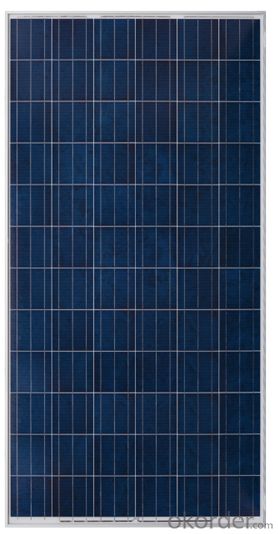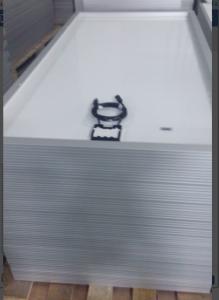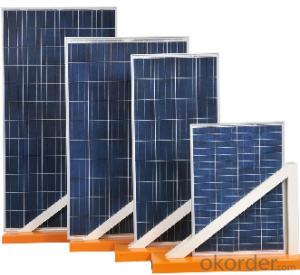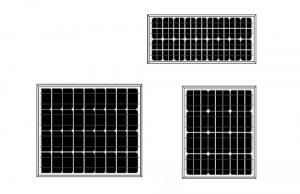Solar Panels US - Polycrystalline Silicon Solar Modules 60cell-240w
- Loading Port:
- China Main Port
- Payment Terms:
- TT or LC
- Min Order Qty:
- 1000 watt
- Supply Capability:
- 10000000 watt/month
OKorder Service Pledge
OKorder Financial Service
You Might Also Like
1. Structure of Polycrystalline Silicon Solar Modules 60Cell-240W Description
Solar panel refers either to a photovoltaics (PV) module, a solar hot water panel, or to a set of solar photovoltaics modules electrically
connected and mounted on a supporting structure. A PV module is a packaged, connected assembly of solar cells. Solar panels can be
used as a component of a larger photovoltaic system to generate and supply electricity in commercial and residential applications. Each
module is rated by its DC output power under standard test conditions, and typically ranges from 100 to 320 watts. The efficiency of a
module determines the area of a module given the same rated output – an 8% efficient 230 watt module will have twice the area of a 16%
efficient 230 watt module. There are a few solar panels available that are exceeding 19% efficiency.
2. Main Features of the Polycrystalline Silicon Solar Modules 60Cell-240W
• WARRANTIES
- 10-year limited product warranty1.
- Limited power warranty1: 1 year at 98% of the minimal rated power output, 10 years at 92% of the minimal rated power output, 25 years at
82% of the minimal rated power output.
Successfully endureü ammonia and salt-mist exposure at the highest severity level, ensuring their performance in adverse conditions.
- High efficiency, multicrystalline silicon solar cells with high transmission and textured glass deliver a module effi ciency of up to 16.0%,
minimizing installation costs and maximizing the kWh output of your system per unit area.
3. Polycrystalline Silicon Solar Modules 60Cell-240W Images



4. Polycrystalline Silicon Solar Modules 60Cell-240W Specification
窗体顶端 Electrical parameters at Standard Test Conditions (STC)窗体底端 | |||
Power output | P max | W | 240 |
Power output tolerances | ΔP max | W | 0 / + 5 |
Module effi ciency | η m | % | 14.8 |
Voltage at Pmax | V mpp | V | 29.3 |
Current at Pmax | I mpp | A | 8.18 |
Open-circuit voltage | V oc | V | 37.5 |
Short-circuit current | I sc | A | 8.75 窗体底端 |
5. FAQ of Polycrystalline Silicon Solar Modules 60Cell-240W
Q1:Can we visit your factory?
A1:Sure,welcome at any time,seeing is believing.
Q2:Which payment terms can you accept?
A2:T/T,L/C,Moneygram,Paypal are available for us.
- Q: Can solar panels be installed on a boat?
- Yes, solar panels can be installed on a boat.
- Q: Are there any maintenance requirements for solar panels?
- Yes, solar panels do have maintenance requirements. While they are generally low maintenance, they need to be kept clean and free from debris to ensure optimal performance. Periodic inspections for any damage or shading issues are also recommended. Additionally, the electrical connections and inverters may require occasional maintenance or servicing.
- Q: Can solar panels be used for powering electric fences?
- Yes, solar panels can be used to power electric fences. Solar panels can generate electricity that can be stored in batteries and used to power electric fence systems, providing a reliable and eco-friendly source of energy for the fences.
- Q: Can solar panels be damaged by hail or other weather conditions?
- Yes, solar panels can be damaged by hail or other severe weather conditions. Hailstones can cause cracks or dents on the surface of the panels, which can affect their efficiency or even render them inoperable. Other extreme weather conditions like high winds, heavy snow, or lightning strikes can also potentially cause damage to solar panels. However, it is important to note that modern solar panels are designed to withstand a certain level of weather-related stresses and are often tested for durability.
- Q: I really want a projector but i hear they use a lot of energy because of the lamp. I want a good one to watch movies and play games on. but i don't want one that is gonna kill the lighting bill.is there like a solar panel or something i could use for it. PLZ HELP.
- Do understand, that a solar panel is slow to pay for itself. Let's say your electric bill was $200 a month ($2400 a year). A solar system would cost perhaps $24,000 so you would actually have paid your first 0 years of electricity in advance when installing the panels. After that 0 years, you start to be ahead financially. It can still be a good idea, but it may not be the quick and cheap solution you were looking for.
- Q: Im curious because I read about a boy who invented a 3d solar panel, using a pyramid he designed a solar panel that collects light more efficiently. Now I have a question. Why cant I design a solar panel that takes adventage of convex and concave mirror's and use a surface that collects light and then focus's the suns energy into a beam and take the beam into a chamber where the solar panels are sitting and surround them with mirrors as well, so any light not obsorbed by one particular spot is reflected to another area for reabsorbtion. I know solar panels dont absorb light but perhaps that will allow more light to create the effects it needs.
- I okorder /
- Q: Heard you can put solar panels on laptops Anyone know if it can work on a Dell mini 0v? I've seen he USB slot solar pana but can someone tell me where to gt these?
- If okorder /
- Q: Still researching for a car that fully uses solar power energy, suggestions would be nice to.
- Not okorder /
- Q: How many solar panels do you need on your house to power your heater in winter?
- Your house, and probably your yard wouldn't be big enough to hold them. I did this exercise once (not doing it again) for someone who wanted to replace his 6hp outboard motor with a solar powered one. The calculations ended up that he would need something like .5 acres of solar panels to get that much energy. Not happening. That said, an passive solar home, can get a significant amount of warmth from the sun directly. But it doesn't work very well at night, when it's coldest. (wonder why that is... probably a climate scientist could help us with that? -- oh, wait. They say warming doesn't have anything to do with the sun.) Edit. I didn't use theoretical stuff to come up with my numbers, I used the claims of actual off-the-shelf solar panels sold by West Marine, calculated the power, and did the math based on existing panels.
Send your message to us
Solar Panels US - Polycrystalline Silicon Solar Modules 60cell-240w
- Loading Port:
- China Main Port
- Payment Terms:
- TT or LC
- Min Order Qty:
- 1000 watt
- Supply Capability:
- 10000000 watt/month
OKorder Service Pledge
OKorder Financial Service
Similar products
Hot products
Hot Searches
Related keywords




























